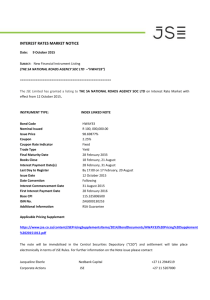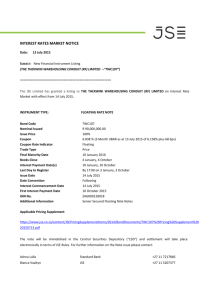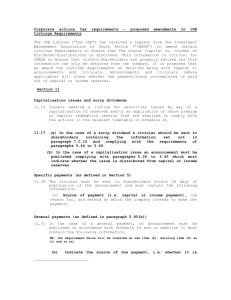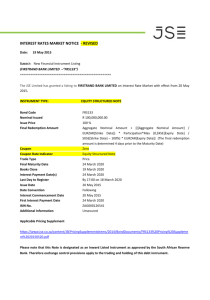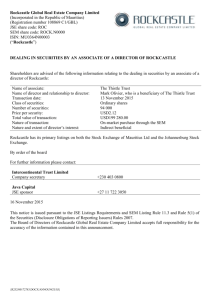An International Journal on the Teaching and Learning of
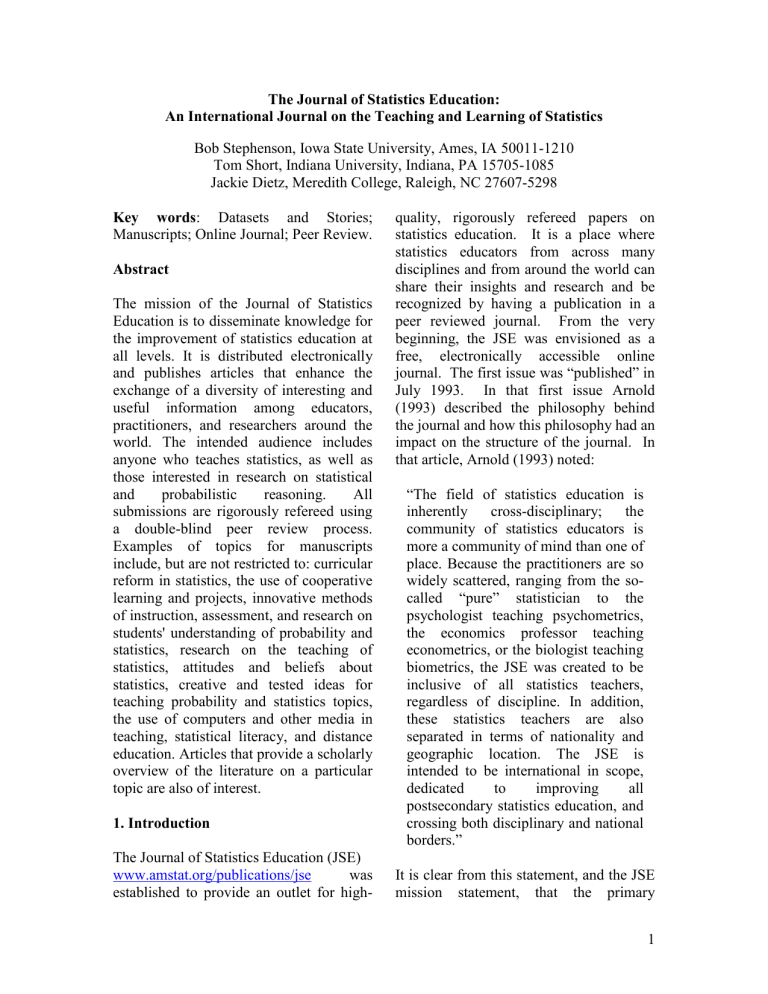
The Journal of Statistics Education:
An International Journal on the Teaching and Learning of Statistics
Bob Stephenson, Iowa State University, Ames, IA 50011-1210
Tom Short, Indiana University, Indiana, PA 15705-1085
Jackie Dietz, Meredith College, Raleigh, NC 27607-5298
Key words : Datasets and Stories; quality, rigorously refereed papers on
Manuscripts; Online Journal; Peer Review.
Abstract
The mission of the Journal of Statistics
Education is to disseminate knowledge for the improvement of statistics education at all levels. It is distributed electronically and publishes articles that enhance the exchange of a diversity of interesting and useful information among educators, practitioners, and researchers around the statistics education. It is a place where statistics educators from across many disciplines and from around the world can share their insights and research and be recognized by having a publication in a peer reviewed journal. From the very beginning, the JSE was envisioned as a free, electronically accessible online journal. The first issue was “published” in
July 1993. In that first issue Arnold world. The intended audience includes anyone who teaches statistics, as well as those interested in research on statistical and probabilistic reasoning. All submissions are rigorously refereed using a double-blind peer review process.
Examples of topics for manuscripts include, but are not restricted to: curricular reform in statistics, the use of cooperative learning and projects, innovative methods of instruction, assessment, and research on students' understanding of probability and statistics, research on the teaching of statistics, attitudes and beliefs about statistics, creative and tested ideas for teaching probability and statistics topics, the use of computers and other media in teaching, statistical literacy, and distance education. Articles that provide a scholarly overview of the literature on a particular topic are also of interest.
1. Introduction
The Journal of Statistics Education (JSE) www.amstat.org/publications/jse was established to provide an outlet for high-
(1993) described the philosophy behind the journal and how this philosophy had an impact on the structure of the journal. In that article, Arnold (1993) noted:
“The field of statistics education is inherently cross-disciplinary; the community of statistics educators is more a community of mind than one of place. Because the practitioners are so widely scattered, ranging from the socalled “pure” statistician to the psychologist teaching psychometrics, the economics professor teaching econometrics, or the biologist teaching biometrics, the JSE was created to be inclusive of all statistics teachers, regardless of discipline. In addition, these statistics teachers are also separated in terms of nationality and geographic location. The JSE is intended to be international in scope, dedicated to improving all postsecondary statistics education, and crossing both disciplinary and national borders.”
It is clear from this statement, and the JSE mission statement, that the primary
1
audience for the journal consists of teachers of statistics. Because statistics teachers should be informed and knowledgeable about how and why students learn, or fail to so, research on statistical and probabilistic reasoning is an important component of the journal.
However, this is not the only component.
The JSE has a very broad mission involving all levels of statistics education.
Although Arnold (1993) mentions only postsecondary statistics education, the JSE includes K-12 statistics education, especially when it deals with pre-service or in-service teachers.
What then are suitable topics for submission to the JSE? In Section 2 we look at articles published in recent issues and comment on how they align with the mission statements’ partial list of suggested topics. In Section 3, we give some suggestions for what not to submit.
Section 4 provides some common mistakes the editorial board sees in submissions on topics that fit the mission statement. Concluding remarks are made in the final section.
2. Recently Published Articles
Those teaching statistics have a wide variety of interests from curriculum reform to what to teach for a specific topic at a particular level. This wide spectrum is illustrated by several of the recently published articles in the JSE.
In “Developing Tomorrow’s Statisticians,”
Bryce (2005) argues for a new paradigm in statistics education that values and supports strong undergraduate programs in statistics. This argument goes beyond curriculum reform to making a case for recognition, within the statistics profession and beyond, of the importance of undergraduate programs in statistics.
Ward (2004) presents the results of a study that compares “… students’ performance and attitudes in a hybrid (blend of online and face-to-face) model of Elementary
Statistics and a traditional (face-to-face) model of the same course. … The value of hybrid courses as a viable option in distance education and their potential benefits to students and the educational institution are discussed.” This paper touches on many of the suggested topics in the JSE mission statement including, innovative methods of instruction, use of the computer, distance education, evaluation of student attitudes, and assessment of student performance. More and more, associate editors and reviewers are looking for more than one component in a manuscript. It is often not sufficient to simply present an innovative method of instruction. Instead, that innovative method of instruction should be accompanied with some assessment of how effective that method is. I see the inclusion of an assessment component as trend that will continue, and may get even more emphasis, in the future.
Teachers of statistics must be aware of the most appropriate methods to teach in their classes and so the JSE publishes papers that inform teachers of appropriate methodology. The paper by Olsson (2005) looks at constructing confidence intervals for the mean when the data come from a log-normal distribution. The naïve approach, taking the log of the data, computing the usual normal theory interval and transforming the end points back using the anti-log, is shown to have very poor coverage properties. Several alternative methods for constructing confidence intervals are given and discussed in this article.
2
Another appropriate topic is the innovative use of computers in teaching statistics.
Vaughn and Berry (2005) present “… an in-class Monte Carlo demonstration, designed to demonstrate to students the implications of multicollinearity in a multiple regression study.” The demonstration involves a known relationship but with two different sets of data. One set of data involves explanatory variables that are independent and the other has correlated predictor variables.
The demonstration clearly shows the effects of correlated predictors on the estimated standard errors of the regression coefficients.
Note that the last two examples deal with topics beyond the introductory course in statistics. Of course the introductory course in statistics is a suitable topic for submission to the JSE but other courses from school level through all of college and graduate school are also suitable.
The Journal of Statistics Education also publishes, “… tested ideas for teaching probability and statistics topics.” An example of this appears in Richardson,
Gabrosek, Reischman, and, Curtiss (2004).
They “… discuss a data collection and analysis activity for illustrating simple linear regression and outlier analysis. …
Students collect data on occurrences of letters in English text. These data are used to study the relationships between how often a letter occurs in English text, and:
(1) the letter’s Morse Code units and (2) the relative frequency of Scrabble ™ game tiles for the letter.” This activity could be used in either an introductory statistics course or in a second course dealing with regression analysis.
Data are an important part of statistics and teaching statistics. The JSE is unique in publishing peer-reviewed articles describing, and making available to readers, interesting data sets. Dataset and
Stories section “… provide(s) a forum for exchanging interesting data and discussing ways that such data can be used effectively in teaching statistics.” Lock (1993). The discussion of how the data can be effectively used in teaching is an integral part of all articles in this section. Without this discussion, the dataset and story, nomatter how interesting, will not be accepted. Recent Datasets and Stories articles have looked at a dataset with lots of outliers (Hayden, 2005), data from a TV show (Kalist, 2004), microbiological data
(Binnie, 2004) and data on drug interactions (Bradstreet and Panabianco,
2004). If you do plan to submit a paper to the Datasets and Stories section, you should follow the submission guidelines for that section. Also, clearly indicate that you are submitting to that particular section of the journal.
3. What not to submit
Given the mission of improving statistics education and recognizing that the primary audience is teachers of statistics, certain articles are inappropriate for the JSE. For example;
Articles that deal entirely with a theoretical result, the derivation and proof, are often not appropriate for JSE. There are lots of journals that publish theoretical results in probability and statistics and those journals are the most appropriate venues for such results.
Articles on educational statistics that have nothing to do with the teaching of statistics are not appropriate. There is a difference between educational statistics, data
3
and studies on education in general, and statistics education, topics dealing with the teaching and learning of statistics.
Articles that describe analysis of data in a particular field are often not appropriate for the JSE. These types of articles are often directed at readers familiar with the subject matter area, e.g. ecology, epidemiology, and public health, present applications of statistical methods to that discipline. If the focus is on the analysis of data for consumption by researchers in other disciplines, the article should be submitted to a journal in that discipline. There is one caveat.
Analysis of data from another discipline may be appropriate as a
Datasets and Stories submission provided the focus of the analysis is to improve the teaching of statistics.
4. Common Mistakes to Avoid
Even when manuscripts fit the mission of the JSE, they often have flaws that should have been corrected before submission.
Many manuscripts have multiple spelling and grammatical errors. All submissions should be checked for spelling and grammar before submission. The automatic spelling checkers will catch obvious spelling mistakes but will not catch things such as the substitution of
“there” for “their”. I have less confidence in the automatic grammar checkers. It is always a good idea to have a colleague read the paper for spelling and grammar.
That colleague should have a good command of the English language and writing conventions and does not need to be a statistician.
Another common mistake involves incomplete and obvious mistakes in the references. Make sure that all citations in the text match an item in the list of references. Also, do not include additional items in your reference list that are not cited in the text of your manuscript. Refer to the instructions for authors available on the JSE website www.amstat.org/publications/jse/jse_auth or_info.html
You will see several references there to the
American Statistical Association Style
Guide www.amstat.org/publications/index.cfm?f
useaction=style-guide This style guide gives specific instructions on the proper way to cite references in the text and how to list them in your references at the end of the article.
A more serious flaw is a narrow or biased review of the literature. It is not uncommon for manuscripts to refer to one or two, or no, previously published works when there are many more articles out there. Some of this may be due to not using computerized searches correctly.
The Current Index of Statistics (CIS) www.statindex.org/CIS/query/ is a good place to look for articles that deal with theory and applications of statistics. It is not your complete guide to research, especially in statistics education. Use the search facility on the JSE website. I am amazed at the number of papers submitted to the JSE that do not include citations to papers published in the JSE. Because statistics education is a relatively new area, many articles pertinent to statistics education have been published in mathematics education or psychology education journals. If you cite an article in the JSE, or Teaching Statistics or the
Statistics Education Research Journal , look at the list of references for that article
4
for additional references. Google Scholar http://scholar.google.com
has opened up a whole new avenue for searching for references on the internet. Do not rely on one source, but rather use a variety of sources for your literature review. Some of these may involve old-fashioned, noninternet based methods.
Be sure to use appropriate data analysis for the data in your manuscript. As statistics educators we should model good statistical practice. A too simplistic or an incorrect analysis of data should be avoided. It is fine to use more advanced statistical techniques to analyze assessment data or data on student attitudes, provided that analysis is appropriate and done correctly.
It is also acceptable to use qualitative methods, again provided they are appropriate and done correctly.
Good statistical practice should also be employed in any proposed student activity.
It is not good statistical practice to have students flip a coin 10 times and repeat this 5 times and claim that this is a good demonstration of the Law of Large
Numbers.
With the growing interest in statistics education and more options for publication of results, the bar for what constitutes a good study in statistics education has been raised. Studies involving small sample sizes are sometimes appropriate but larger sample sizes are almost always better.
Studies that are done with only one class of students, especially if there is no comparison group, will rarely be received well by Associate Editors and referees.
The statistics education community is becoming more aware of the need and use of good assessments of student outcomes in statistics. Again, the bar seems to be raising with demands for assessment data supporting claims of an improved curriculum, a better way of presenting statistical concepts or methods, an effective activity for improving student understanding. Attitudes of students are still important but using students’ attitudes as the sole measure of a better way of teaching and learning statistics is not sufficient.
5. Conclusions
The Journal of Statistics Education is a broad based journal both in terms of audience and in terms of content. It tries to appeal to all levels of statistics education from K-12 to graduate school.
It also tries to reach out to teachers of statistics in different disciplines both in the
U.S. and internationally who are teaching in a traditional setting and those involved in distance and online learning. Because of this broad mission, the JSE publishes a wide variety of articles dealing with statistics curriculum, innovative methods of instruction, assessment, and research on students' understanding of probability and statistics, and research on the teaching of statistics, attitudes and beliefs about statistics. Because we wish to inform and assist teachers of statistics, creative and tested ideas for teaching probability and statistics topics and the use of computers and other media in teaching are also appropriate topics for manuscripts. The
JSE is also a place where interesting data sets together with how the data and analysis can be effectively incorporated into a teaching and learning situation can be published.
It is truly fortunate that the statistics education community has multiple forums for the submission of scholarly work. I see other journals, like Teaching Statistics
5
and the Statistics Education Research
Journal, not as competition for manuscripts but as providing complimentary avenues for the dissemination of knowledge about statistics education.
Acknowledgement
I would like to thank Carol Blumberg for her ideas on common flaws in manuscript submissions.
References
Arnold, T. (1993), “The Structure and
Philosophy of the Journal of Statistics
Education,”
Journal of Statistics
Education [Online], 1(1). www.amstat.org/publications/jse/v1n1/arn old.html
Binnie, N. (2004), “Using EDA, ANOVA and Regression to Optimise some
Microbiology Data,”
Journal of Statistics
Education [Online], 12(2). www.amstat.org/publications/jse/v12n2/da tasets.binnie.html
Bradstreet, T.E. and Panebianco, D.L.
(2004), “An Oral Contraceptive Drug
Interaction Study,” Journal of Statistics
Education [Online], 12(1). www.amstat.org/publications/jse/v12n1/da tasets.bradstreet.html
Bryce, G.R. (2005), “Developing
Tomorrow’s Statistician,”
Journal of
Statistics Education [Online], 13(1). www.amstat.org/publications/jse/v13n1/br yce.html
Hayden, R.W. (2005), “A Dataset that is
44% Outliers,”
Journal of Statistics
Education [Online], 13(1). www.amstat.org/publications/jse/v13n1/da tasets.hayden.html
Kalist, D.E. (2004), “Data from the
Television Game Show ‘Friend or Foe?’”
Journal of Statistics Education [Online],
12(3). www.amstat.org/publications/jse/v12n3/da tasets.kalist.html
Lock, R. (1993), “Datasets and Stories:
Introduction and Guidelines,”
Journal of
Statistics Education [Online], 1(1). www.amstat.org/publications/jse/v1n1/dat asets.html
Olsson, U. (2005), “Confidence Intervals for the Mean of a Log-Normal
Distribution,” Journal of Statistics
Education [Online], 13(1). www.amstat.org/publications/jse/v13n1/ol sson.html
Richardson, M., Gabrosek, J., Reischman,
D., and Curtiss, P. (2004), “Morse Code,
Scrabble, and the Alphabet,”
Journal of
Statistics Education [Online], 12(3). www.amstat.org/publications/jse/v12n3/ri chardson.html
Vaughn, T.S., and Berry, T.E. (2005),
“Using Monte Carlo Techniques to
Demonstrate the Meaning and
Implications of Multicollinearity,”
Journal of Statistics Education [Online], 13(1). www.amstat.org/publications/jse/v13n1/va ughan.html
Ward, B. (2004), “The Best of Both
Worlds: A Hybrid Statistics Course,”
Journal of Statistics Education [Online],
12(3). www.amstat.org/publications/jse/v12n3/w ard.html
6
